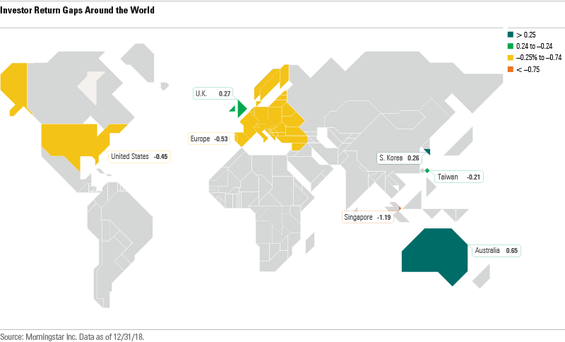The investor-returns gap—which measures the gap between average investor and average official fund returns—is shrinking and returns are rising.
The findings about this gap are detailed in the second global “ Mind the Gap” study, which compares asset-weighted investor returns with straight averages of category returns to compare the average fund with the average investor. These results give us some insight into where global investors make good use of funds and where they don’t.
In general, investor-return gaps expand in dramatic pivot years as investors react abruptly to market changes, but steady gains over most of the 2010s have made it easier for investors to stay the course.
This year’s study also included several enhancements.
- We included extinct funds in order to avoid survivorship bias. We achieved this data through a portfolio calculation that used monthly flows and returns for funds, so extinct funds would be included until their merger or liquidation date. This also had the benefit of more precisely capturing the timing and impact of monthly flows than our past studies have.
- We included exchange-traded funds for the first time by comparing monthly assets under management and returns. This meant we didn’t capture short-term trades in ETFs but did capture longer-term flows.
Below, explore some of our key conclusions about the gap in global investor returns.
Overall investor-returns gaps ranged substantially by country
Our research found the gap ranged from a negative 119-basis-point gap per year (in Singapore) to a positive 65-basis-point gap (in Australia). The U.S. gap was negative 45 basis points and Europe was negative 53 basis points.
These returns are shown on the chart below.

Asset-allocation funds help investor returns
Looking at fund groups, we found that asset-allocation funds tended to have the biggest gaps. For example:
- U.S. allocation funds produced a positive gap of 0.22% above annualized returns of 5.54%.
- European asset-allocation returns were 32 basis points above annualized returns of 3.72%.
- Australian allocation fund investors topped official returns by 72 basis points.
There are two likely explanations for this trend. One is that allocation funds generally mute the swings of pure equity funds and thus avoid producing the extremes that trigger investors to make poor timing moves. The second is that in some markets, such as the U.S., allocation funds are the preferred vehicle for automatic savings vehicles like 401(k)s.
Factors affecting investor returns
For the study, we also explored the factors that may play a role in investor-return gaps. Specifically, we looked at investor returns by expense ratios and standard deviation, finding that low costs and low-volatility funds tend to produce higher investor returns in most markets and asset classes.
This suggests there are actions that investors and investment professionals can take to improve real-world results. Investors fare better in lower-cost, less-volatile funds and everyone involved in the investment process can work to help investors down that path.

